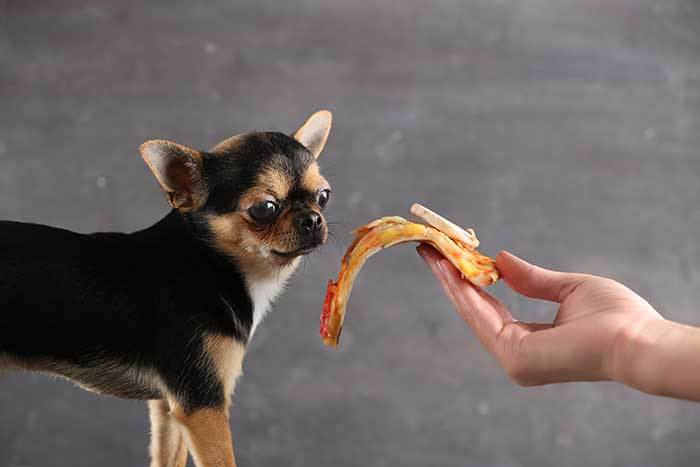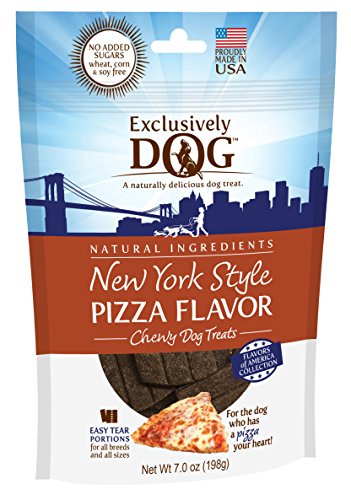You may be wondering “Is Pizza Safe for Dogs?” Or “Can Dogs Eat Pizza?”
The plain and simple answer is “NO,” dogs cannot eat pizza. And the main reason why vets discourage pizza for dogs is that the ingredient makeup of most pizzas contains at least one ingredient that’s potentially harmful to dogs.
Now, pizza isn’t only discouraged for dogs. Experts have consistently raised concerns about the possible dangers that the food could pose to humans, its yummy and delectable taste notwithstanding.
And the fact that it’s one of the most accessible fast foods out there makes it all the more worrying.
However, dogs have a penchant for begging for human foods. And their owners are generally inclined towards granting their requests.
So, what should you do if you just can’t resist the temptation of offering some pizza to your dog? Well, there might be a safer way to feed pizza to dogs. Read on to find out.
Common Ingredients Used In Pizza
You may be a pet owner and are always asking yourself, is it ok for dogs to eat pizza?
Well, since the food is generally discouraged, you should start by understanding the common ingredients that make it a no-no for dogs.
The following are some of the most popular pizza toppings;
1. Pepperoni
2. Onions and Garlic
3. Black olives
4. Mushrooms
5. Green peppers
6. Pineapple
7. Sausage
8. Extra cheese
9. Bacon
10. Tomatoes
11. Anchovies
12. Spinach
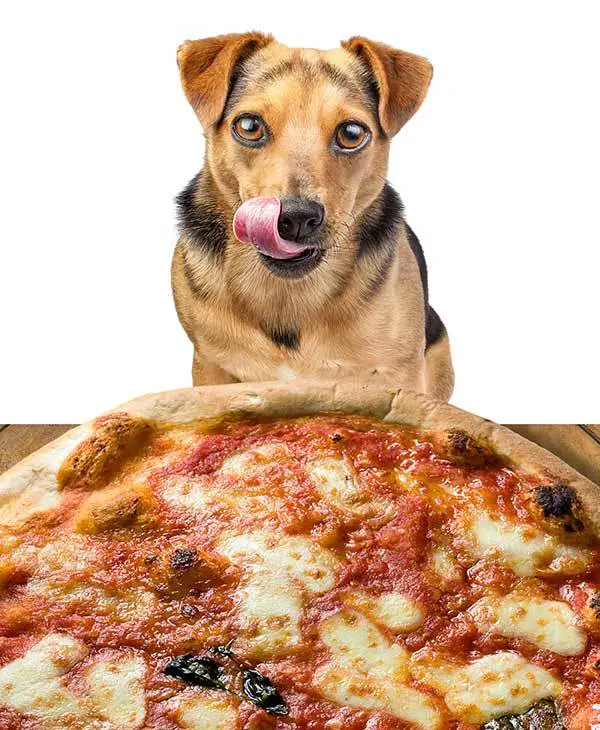
Now, let’s examine each ingredient separately and see whether it’s safe or harmful to dogs.
Pepperoni typically comprises of fennel seeds, paprika, garlic powder, mustard seed, and black pepper. It’s these ingredients that give pepperoni its spicy flavor.
On the whole, pepperoni isn’t toxic for dogs. However, it’s generally not recommended. That’s because it contains unhealthy levels of fat and sodium, plus too much seasoning.
So, can dogs eat pepperoni? And what about the pizza itself, can dogs eat pepperoni pizza?
As we’ve already mentioned, pepperoni alone isn’t toxic. It all depends on the amount you offer to the dog. But if you can, avoid pepperoni pizza altogether.
Onions and garlic have been proven to cause extreme toxicity in dogs. If your dog ingests onions or garlic, especially in large quantities, it could lead to anemia and Heinz body formation.
Signs of onion or garlic poisoning include gastrointestinal complications, such as nausea, vomiting, and diarrhea, generalized fatigue, pale mucous membrane, labored breathing, to mention but a few.
Therefore, the presence of garlic and onions alone in pizza makes the food highly toxic for dogs.
Black olives contain essential fatty acids that come with a host of health and nutritional benefits for dogs.
Aside from boosting your dog’s immunity, the fruit also makes the dog’s coat shiny and radiant. Of course, there’s the little concern of choking risks from the pit. But you don’t expect the pit to be present in pizza, do you?
Overall, black olives are safe and nutritionally beneficial to dogs.

Mushrooms are some of the essential foods for dogs out there. Mushroom contains high amounts of fiber that might boost your canine’s bowel activity, as well as help with weight management.
Besides, it boasts high levels of protein, which is excellent for muscle and tissue development. Not to mention, the antioxidant selenium that prevents the effects of free radicals, thereby boosting the overall immunity of your dog.
Evidently, mushrooms are absolutely safe and nutritious for dogs. But there’s a caveat – it must be an edible variety.
Be wary of mushrooms that grow outdoors or in the wild, as those could contain very toxic compounds. So overall, mushroom is another ingredient that makes pizza a welcome treat for canines.
What of green pepper? There haven’t been many documented side effects of green pepper for dogs.
Like mushrooms and black olives, green pepper is also laden with powerful antioxidants and is generally safe for dogs. However, it’s notorious for causing an upset stomach if the dog consumes large amounts of it. Overall, it’s a great pizza topping.
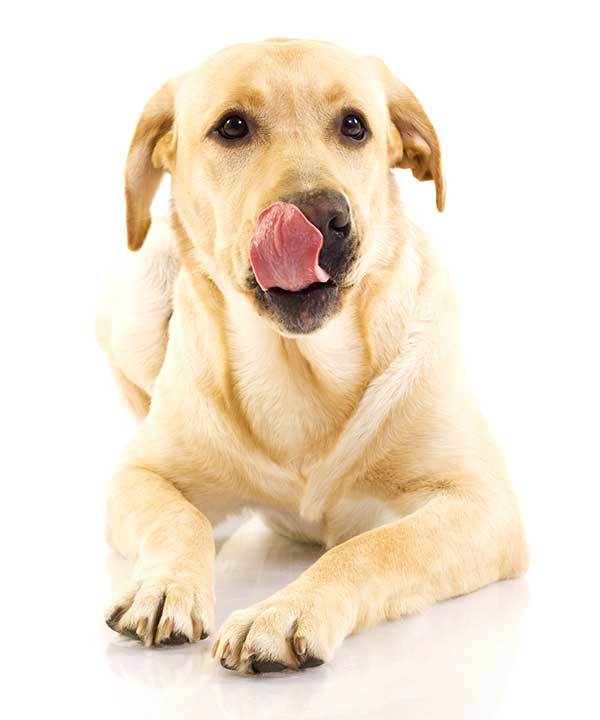
Raw pineapple is another popular food that experts recommend for dogs, though as a snack. It comes with a host of health and nutritional benefits. Not only does it help ease constipation due to its abundance of fiber.
Raw pineapple is also beneficial for arthritic dogs. Plus, it boasts powerful antioxidant and anti-inflammatory compounds that prevent chronic diseases. Which brings us to the question, can dogs eat ham and pineapple pizza?
In particular, pineapple is safe for dogs. Just ensure you always go for fresh as opposed to canned or frozen pineapple. Generally, pineapple is a safe ingredient in pizza.
Sausage isn’t a recommended treat for dogs, and its presence in pizza makes it a real concern. A common side effect of snacking on sausage includes an upset stomach.
Also, it contains worrying levels of sodium, which could affect your dog’s heart and kidneys in the long run.
Sausage has also been shown to cause pancreatitis. Therefore, it’s a no-no for dogs and if you can, go for pizza that doesn’t contain this ingredient.
Cheese has always featured among the harmful foods for dogs. Though some pet owners may prefer it due to its significantly low content of lactose, cheese interacts with a dog’s system in a similar manner as most other dairy products.
Some of the symptoms it causes include nausea, diarrhea, vomiting, and flatulence. And the fact that pizza contains an excess of it speaks to its potential hazards.

Bacon isn’t very different from sausage in terms of how it affects dogs. Due to its high salt content, bacon can interfere with your canine’s kidneys and pancreas.
It also presents a host of gastrointestinal complications, such as diarrhea. So, avoid pizza that contains bacon as one of the toppings.
Tomatoes are generally harmless to dogs. Not only that, but they’re also rich in essential dietary elements. Tomatoes contain the antioxidant lycopene. This compound is linked to numerous health benefits, including lowering the risks of cancer, diabetes, and heart disease.
Tomatoes are also rich in Vitamin C, another immune-boosting element. Your only concern would be solanine and the alkaloid tomatine.
These two substances are especially abundant in tomato stems, leaves, and young green tomatoes. However, they are both metabolized as the fruit ripens.
So, tomatoes are a great pizza topping. You only have to ensure the fruits used are ripe enough, which is fortunately often the case.

We all love anchovies, and our dogs probably like them a bit more. Anchovies pack omega-3 fatty acids, which are associated with improved vision and immunity.
Omega-3 fatty acids also promote a healthy brain and heart. Your only worry would be the kind of anchovies used for pizza. Always insist on anchovies that are packed in water, as opposed to those packed in oil or salt.
Lastly, there’s spinach. Spinach is frequently ranked among the top superfoods. That speaks to its immense health and nutritional benefits.
From relieving indigestion to improving your dog’s immunity, spinach comes with a cocktail of benefits for dogs. Therefore, among the top twelve pizza toppings we’ve reviewed here, spinach is the most preferable.
The only problem would be the oxalates present in the vegetable. But then again, experts agree that it would take your dog years of exposure to excess spinach for the oxalates to pose any serious threats.
- Works as a dog food topper – For pet parents looking for an alternative to capsules, raw treats, or soft chews, all it takes is a few pumps of Salmon…
- A tasty & body nourishing treat for cats & dogs – Essential fatty acids for a healthy coat.
- Powerful Omega Fatty Acids – This premium fish oil liquid formula is loaded with the healthy Omega-3 fatty acid (with epa and dha) to support health…
Last update on 2025-01-15 / Affiliate links / Images from Amazon Product Advertising API
Now, having carefully examined the popular pizza toppings, you might be wondering, can pizza kill dogs?
Sadly, pizza can kill dogs, especially if it contains all the harmful toppings and is prepared in rather unhygienic conditions.
But in most cases, you can only expect that your dog becomes sick after eating pizza. The symptoms will vary depending on the amount of pizza that the dog has eaten and the toxicity of the ingredients in the food.
Is Pizza Bad for Dogs?
As we’ve already mentioned, it all comes down to the amount of pizza the dog eats. Indeed, that applies to all human foods.
Offering small bites of pizza to your dog shouldn’t be a concern at all. However, you should be a distraught pet owner if you discover your dog ate pizza behind your back, especially if he helped himself to large amounts of it.
Remember that pizza comes with attractive smells and a pleasant flavor. Therefore, it won’t be long before your pooch discovers where you’re hiding the delicacy.

Besides the potential dangers of some of its ingredients, pizza isn’t prepared to accommodate your dog’s nutritional requirements.
Now, this may sound paradoxical, considering we’ve highlighted numerous possible dietary benefits of various pizza toppings.
However, you should remember that the way the human body absorbs these nutrients isn’t similar to how your dog’s body would. And in most cases, the food isn’t prepared in a manner that preserves its dietary elements. So, after all is said and done, those benefits may only exist in theory.
If you aren’t comfortable feeding pizza to your dog, then avoid all circumstances that would lead to the dog accessing the food. For instance, always clear the table of leftovers.
Besides, you should safely tuck any leftover pizza in the trash can, then seal it tight to prevent your dog from scavenging for pizza leftovers in the garbage. It’s also unwise to snack on the delicacy with your pooch in plain sight.
- Contains (1) 38.5 lb. bag of IAMS Adult Dry Dog Food Lamb and Rice
- 1st ingredient is real, premium lamb
- Promotes healthy digestion with a tailored blend of wholesome fibers and prebiotics
Last update on 2025-01-03 / Affiliate links / Images from Amazon Product Advertising API
But what if I’m okay feeding the food to my pooch, can my dog eat pizza?
If you’d like to offer some pizza to your dog, check with the restaurant on the kind of ingredients they use. Keep an eye out for onions and garlic, as they’re the most dangerous pizza ingredients.
Many restaurants nowadays offer provisions for ordering pizza without onions, hot peppers, and many other condiments. Garlic is normally added as a source.
Therefore, the best way to avoid it is to order pizza with a sauce. Otherwise, the food will come with garlic already added to it.
My Dog Ate Pizza, What Should I Do?
In light of the heavy debate around pizza, you may be wondering what to do if your dog eats pizza?
Now, there are two things to establish even before you can take the necessary action.
First, how much of the pizza has your dog eaten? Another question you must ask yourself is, what sort of ingredients does the pizza contain?
The safer the toppings, the more unlikely the dog is to suffer gastrointestinal issues. And if the canine only stole or scavenged on small amounts of pizza, you shouldn’t be worried either.
And that helps settle the common questions, “can dogs eat a slice of pizza?” and “can dogs eat small amounts of pizza?”.
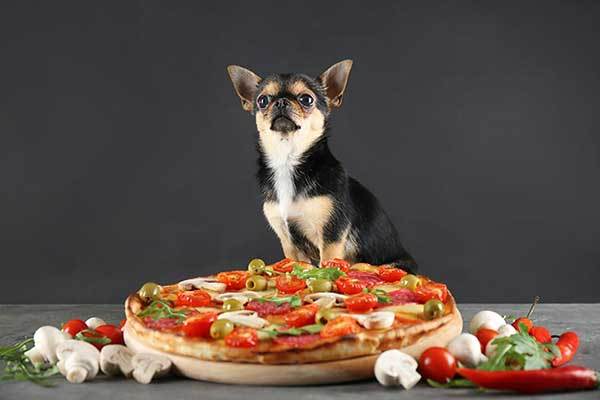
However, if your pooch happens to have gulped down too much of the food, you should understand the side effects to watch out for.
An upset stomach will almost always result from overeating pizza. So, check for signs like nausea, vomiting, and diarrhea. There are numerous home remedies for diarrhea that you can apply to help relieve your dog’s upset stomach.
But even if symptoms don’t present themselves immediately, you should still schedule an appointment with your vet.
Remember that most health implications of the harmful ingredients in pizza are normally long-term. Your vet will examine the dog’s exposure to long-term toxicity and prescribe an appropriate treatment course.
Can Dogs Eat Pizza Crusts?
Pizza crust refers to the dough that forms the base of the pizza.
After preparing the dough, it’s made into any of the desired shapes – circular, rectangular, square, etc. It’s then baked before finally topped with a host of ingredients we’ve already discussed here.
When preparing the dough, it may often turn black. And that may leave you wondering, can dogs eat black pizza?
It all depends on the reason for the color. Some pizzas turn black due to the addition of food-grade vegetable charcoal, which is totally fine. However, others turn black if the dough is allowed to over-ferment, which isn’t recommended.

Feeding your dog pizza crusts is a decision you should consider carefully, just as you would when choosing the right toppings for the crust.
But is it ok for dogs to eat pizza crust?
As you may expect, it all comes down to the ingredients used in the crust. Most pizza crusts contain cheese, salt, garlic, butter, and other ingredients that experts generally warn against.
The crust is also high in carbohydrates and calories, which are known risk factors for obesity.
But the most notorious element in pizza crust that makes it a less healthy food for dogs is sodium. And it’s worse considering most pizza crusts feature high amounts of sodium, which may lead to sodium poisoning. The consequences of sodium poisoning could be life-threatening if not properly managed.

If you can substitute the harmful ingredients in pizza crust with more beneficial ones, the better for your dog. For instance, you could replace flour with cauliflower. And you may have wondered to yourself, can dogs eat cauliflower pizza crust?
Well, cauliflower is a healthier alternative to most pizza crust ingredients. That’s primarily due to its grain-free and gluten-free properties.
All in all, you’ll need to establish the kinds of ingredients the crust was prepared with to determine its safety. And that’s something you’ll find very challenging, especially for ready made pizza where the ingredients list isn’t always comprehensive enough.
- Bacon flavored dog treats with real meat as the number 1 ingredient. The original strip that started it all
- Beggin’ Strips for dogs made with real bacon and a texture that allows for easy chewing
- Dog strips that are easy to tear into smaller pieces. These bacon flavored treats contain no artificial flavors or FD and C colors
Last update on 2025-01-18 / Affiliate links / Images from Amazon Product Advertising API
What About The Rolls, Can Dogs Eat Pizza Rolls?
Besides the crust, dogs should also avoid raw pizza dough, commonly known as pizza rolls.
So, “what’s my recourse,” you may ask. If you’d like to offer pizza safely to your pooch, there are two options you may want to explore.
First, always buy pizza-flavored dog treats. That way, you can treat your dog to pizza without exposing him to the harmful ingredients of the food.
Secondly, and more importantly, you can choose to prepare pizza for your dog at home.
Indeed, this is the safest way to feed pizza to dogs, as you’ll personally handpick the ingredients. The internet is awash with numerous homemade pizza-flavored dog treat recipes.
- Made with natural ingredients
- Chicken no.1 ingredient
- No added sweeteners; wheat, corn and soy free
Last update on 2025-01-18 / Affiliate links / Images from Amazon Product Advertising API
Homemade Pizza-Flavored Dog Treat Recipe
The following is a standard recipe you might explore.
Ingredients:
1 cup of wheat or spelt flour.
A few slices of fresh mozzarella.
1/3 cup of white flour.
1 pinch of basil.
1/4 cup of water.
1 pinch of sundried tomatoes.
Directions:
1. Preheat your oven up to a temperature of 375-degrees Fahrenheit.
2. Chop the sundried tomatoes, basil, and cheese into tiny pieces, then set them aside.
3. Combine the different types of flour in a bowl and stir in the chopped pieces, as well as mozzarella.
4. Pour in water and stir till the mixture forms a dry sticky dough. You can add water and flour as required, till you achieve this consistency.
5. Flatten the dough by use of a rolling pin, then cut it into circular pieces with a glass rim.
6. Using a knife, make indents in the circles so that the pieces resemble real pizza slices.
7. Transfer the pieces to a cookie sheet and bake for roughly 20 minutes, or till they’re slightly brown.
Allow the crusts to cool down before serving it to your dog.
- Packed with Protein: IAMS Proactive Health Beef Chunks In Gravy is made with high-quality protein to support your dog’s strong, healthy muscles and…
- Real Ingredients: Our wet dog food is made with real beef for a taste your dog will love
- 100% Complete and Balanced: Feel good serving your best friend a 100% complete and balanced meal for adult maintenance that supports whole body health…
Last update on 2025-01-18 / Affiliate links / Images from Amazon Product Advertising API
Conclusion: So, Can Your Dog Have Pizza?
According to expert advice, avoid offering pizza to your dog as much as you can. But if you must share this yummy food with your pooch, your best bet is to go for homemade options.
Even better, you might replace pizza with other human foods considered safe for dogs.
Checkout Our Favorite Dog Products
1. BEST PUPPY TOY
We Like: Snuggle Behavior Toy with Heart Beat & Heat Pack – Ideal toy for new puppies.
2. BEST DOG TRAINING PROGRAM
We Like: Doggy Dan The Online Dog Trainer – Stop any dog problem and raise the perfect puppy with The Online Dog Trainer.
3. BEST DOG DNA TEST
We Like: Embark Dog DNA Test – Embark screens for over 250 dog breeds + tests for 170+ genetic diseases including MDR1 drug sensitivity, glaucoma, degenerative myelopathy, and dilated cardiomyopathy, some of the most common adult-onset diseases in dogs.
4. Best Bone Broth for Dogs
We Like: (Solid Gold – Human Grade Bone Broth for Dogs) – Simmered Beef Bone Broth With Turmeric Provides A Nutrient-Dense And Flavorful Addition To Your Dog’s Meal + Rich In Natural Collagen From Beef Bones.
5. Best Multivitamin for Dogs
We Like: PetHonesty 10-For-1 Multivitamin – 10 Benefits in 1 Daily Treat – These Multivitamin Snacks combine a well-rounded blend of the most essential vitamins and supplements including glucosamine, probiotics, vitamins and omegas, for dogs’ overall daily health.

